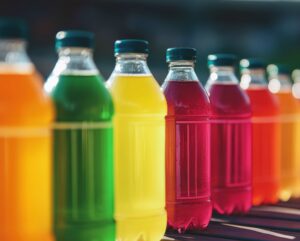While much of our dietary focus goes into what we eat, it’s just as important to be mindful of what we drink

A July 2023 report by USA Facts noted that Americans have more than 500 beverage choices, according to estimates by the U.S. Department of Agriculture. The report also shared data from the Centers for Disease Control and Prevention’s National Health and Nutrition Examination Survey revealing that, between 2017 and 2020, water accounted for 50% of overall beverage consumption, with tap water slightly edging out bottled. The next popular beverages consumed were coffee (14%), soft drinks (10%), milk (7%) and tea (7%). And on any given day during that period, Americans also drank about 4 fluid ounces of alcohol.
While much of our dietary focus goes into what we eat, it’s just as important to be mindful of what we drink, according to Christiane Meireles, PhD, RD, LD, clinical associate professor, School of Nursing, and co-founder, Green Wellness Program: Plants-2-Plate. Read on for her insights about everyday beverages that distinguish myths from facts.
1. Myth or fact? Water is the healthiest beverage.
 Answer: Fact. The human body is about 60% water, with about 7% in the muscles and 10% in fat cells. This means that people need to consume liquid throughout the day to keep the body hydrated. The amount of water needed varies by age, gender and how much fat tissue one has. Water is truly the only beverage the body needs, and it doesn’t have to be a boring drink. Water can be made fun with fruit or herb infusions. To jazz up a seemingly dull glass of water, consider squeezing one or more fruits into the glass, perhaps a lemon, lime, orange, berries, pineapple or a mixture of these. Herbs like mint or rosemary are also great additions. Consider combining herbs with different fruits to create a refreshing drink. For those who like carbonation, consider making or buying carbonated water with or without fruit for a fizzy option.
Answer: Fact. The human body is about 60% water, with about 7% in the muscles and 10% in fat cells. This means that people need to consume liquid throughout the day to keep the body hydrated. The amount of water needed varies by age, gender and how much fat tissue one has. Water is truly the only beverage the body needs, and it doesn’t have to be a boring drink. Water can be made fun with fruit or herb infusions. To jazz up a seemingly dull glass of water, consider squeezing one or more fruits into the glass, perhaps a lemon, lime, orange, berries, pineapple or a mixture of these. Herbs like mint or rosemary are also great additions. Consider combining herbs with different fruits to create a refreshing drink. For those who like carbonation, consider making or buying carbonated water with or without fruit for a fizzy option.
2. Myth or fact? Lack of thirst means you are not dehydrated.
 Answer: Myth. Thirst is not always a reliable indicator for dehydration, especially in older adults who may not experience the thirst sensation as readily. That’s why it’s important to stay alert and be mindful of the possible symptoms of dehydration. These include dry mouth, headaches, fatigue and darker, more concentrated urine.
Answer: Myth. Thirst is not always a reliable indicator for dehydration, especially in older adults who may not experience the thirst sensation as readily. That’s why it’s important to stay alert and be mindful of the possible symptoms of dehydration. These include dry mouth, headaches, fatigue and darker, more concentrated urine.
3. Myth or fact? Drinking too much water can be unsafe.
 Answer: Mostly myth. Water is the healthiest beverage and should be the number one choice of beverages. Drinking too much water is rarely a problem for healthy people. However, something to be mindful of is water toxicity or intoxication, a potentially deadly condition in which one drinks too much water that the body can’t get rid of — about 3 to 4 liters over one to three hours. While this condition is rare, it can result in the blood becoming diluted, causing hyponatremia, a condition in which the sodium level in the blood dips too much. Symptoms include nausea, confusion, seizures and massive spasms, especially if one has been exposed to extreme heat or prolonged, strenuous exercise. Those suffering from this condition should seek medical attention promptly.
Answer: Mostly myth. Water is the healthiest beverage and should be the number one choice of beverages. Drinking too much water is rarely a problem for healthy people. However, something to be mindful of is water toxicity or intoxication, a potentially deadly condition in which one drinks too much water that the body can’t get rid of — about 3 to 4 liters over one to three hours. While this condition is rare, it can result in the blood becoming diluted, causing hyponatremia, a condition in which the sodium level in the blood dips too much. Symptoms include nausea, confusion, seizures and massive spasms, especially if one has been exposed to extreme heat or prolonged, strenuous exercise. Those suffering from this condition should seek medical attention promptly.
4. Myth or fact? Caffeine dehydrates you.
 Answer: Myth. For a long time, it was thought that caffeine could lead to dehydration, but according to recent research, moderate daily caffeine consumption — 250 to 300 milligrams will not cause dehydration. In the short term, it can increase diuresis, or increased urine production by the kidneys, but not dehydration. For context, a cup of brewed coffee can contain about 90 milligrams of caffeine, depending on the strength of the brew. Other factors, like the coffee’s concentration or consuming five or six cups a day, may have a dehydrating effect.
Answer: Myth. For a long time, it was thought that caffeine could lead to dehydration, but according to recent research, moderate daily caffeine consumption — 250 to 300 milligrams will not cause dehydration. In the short term, it can increase diuresis, or increased urine production by the kidneys, but not dehydration. For context, a cup of brewed coffee can contain about 90 milligrams of caffeine, depending on the strength of the brew. Other factors, like the coffee’s concentration or consuming five or six cups a day, may have a dehydrating effect.
5. Myth or fact? Sports drinks keep you better hydrated than water.
 Answer: Myth. In most cases, water is all that is needed for replenishment. In cases of more strenuous exercise, like running a marathon, runners would benefit from a drink that can replenish electrolytes and restore the minerals that are lost through sweat. If one is exercising at the gym for 45 minutes to an hour, for example, water should be fine. Sports drinks should not be consumed daily, but only occasionally. When it comes to kids, sugar and sodium in a sports drink is something that may be problematic. Sports drinks contain large amounts of sodium and are not a good option for kids as a source of replenishment, increasing the risk of high blood pressure.
Answer: Myth. In most cases, water is all that is needed for replenishment. In cases of more strenuous exercise, like running a marathon, runners would benefit from a drink that can replenish electrolytes and restore the minerals that are lost through sweat. If one is exercising at the gym for 45 minutes to an hour, for example, water should be fine. Sports drinks should not be consumed daily, but only occasionally. When it comes to kids, sugar and sodium in a sports drink is something that may be problematic. Sports drinks contain large amounts of sodium and are not a good option for kids as a source of replenishment, increasing the risk of high blood pressure.
6. Myth or fact? Alcohol is associated with increased cancer risk.
 Answer: Fact. Because no amount of alcohol is considered safe, consuming alcohol is a health risk. Therefore, drinking less is better than drinking more. According to some studies, drinking alcohol in moderation may increase one’s overall risk of chronic diseases such as cancer and heart disease, and even death. Those who are pregnant, breastfeeding or under the age of 21 should not drink alcohol. For men, the number one type of deadly cancer associated with alcohol is liver cancer, according to the Centers for Disease Control and Prevention (CDC). In men, alcohol consumption can increase cancers of the mouth, throat, esophagus, voice box, prostate, colon and rectum. For women, who generally absorb more alcohol and take longer to process it than men, the risk of breast cancer increases with any amount of alcohol. In addition, women who drink excessively have a higher risk of damage to the heart muscle at lower levels of alcohol use and over fewer years than men, according to the CDC.
Answer: Fact. Because no amount of alcohol is considered safe, consuming alcohol is a health risk. Therefore, drinking less is better than drinking more. According to some studies, drinking alcohol in moderation may increase one’s overall risk of chronic diseases such as cancer and heart disease, and even death. Those who are pregnant, breastfeeding or under the age of 21 should not drink alcohol. For men, the number one type of deadly cancer associated with alcohol is liver cancer, according to the Centers for Disease Control and Prevention (CDC). In men, alcohol consumption can increase cancers of the mouth, throat, esophagus, voice box, prostate, colon and rectum. For women, who generally absorb more alcohol and take longer to process it than men, the risk of breast cancer increases with any amount of alcohol. In addition, women who drink excessively have a higher risk of damage to the heart muscle at lower levels of alcohol use and over fewer years than men, according to the CDC.
7. Myth or fact? Juicing is healthier than eating whole fruit.
 Answer: Myth. During the juicing process, fiber and bioactive compounds are lost, and calories are often gained since it typically takes more than one fruit to make an 8-ounce drink. Eating whole fruit results in ingesting fewer calories and provides the fiber that is lost when the fruit is juiced. Also, the absorption of sugars from juice as opposed to whole fruit can be so fast that it can spike blood sugar right away, whereas a whole fruit with more fiber takes time to digest, keeping one’s blood sugar at a steadier rate.
Answer: Myth. During the juicing process, fiber and bioactive compounds are lost, and calories are often gained since it typically takes more than one fruit to make an 8-ounce drink. Eating whole fruit results in ingesting fewer calories and provides the fiber that is lost when the fruit is juiced. Also, the absorption of sugars from juice as opposed to whole fruit can be so fast that it can spike blood sugar right away, whereas a whole fruit with more fiber takes time to digest, keeping one’s blood sugar at a steadier rate.
True, false or somewhere in between?
Read more in our myth-or-fact series of conversations with UT Health San Antonio faculty and care providers to test your knowledge about specific health concerns:
- Diet and exercise habits that aid weight loss
- Common assumptions about health
- Ear health and how ears work
- How to protect your eyes
- How to maintain good oral health
- What you can do to boost brain function
